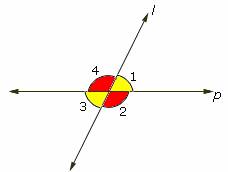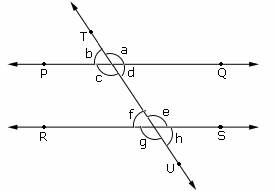Opposite Angles
Definition Of Opposite Angles
When two lines intersect, four angles are formed. The angles that are directly opposite to each other are called Opposite Angles.
More About Opposite Angles
Opposite angles are also called vertically opposite angles.
Opposite angles are always non-adjacent.
When two parallel lines are cut by a transversal, 8 angles or 4 pairs of opposite angles are formed.
Example of Opposite Angles

In the given figure, the lines l and p intersect each other and form four angles.
Among these angles, ∠1 and ∠3, ∠2 and ∠4 are opposite angles.
Video Examples: Vertical or Opposite Angles
Solved Example on Opposite Angles
Ques: Find the pairs of opposite angles in the given figure.

Choices:
A. (a, b), (c, d), (e, f), (g, h)
B. (a, e), (b, f), (c, g), (d, h)
C. (a, c), (b, d), (e, g), (f, h)
D. (a, d), (b, c), (e, h), (f, g)
Correct Answer: C
Solution:
Step 1: When two lines intersect, four angles are formed. The angles that are directly opposite to each other are called opposite angles.
Step 2: From the figure, two lines PQ and RS are cut by the transversal TU forming eight angles.
Step 3: So, (a, c), (b, d), (e, g), (f, h) are opposite angles.